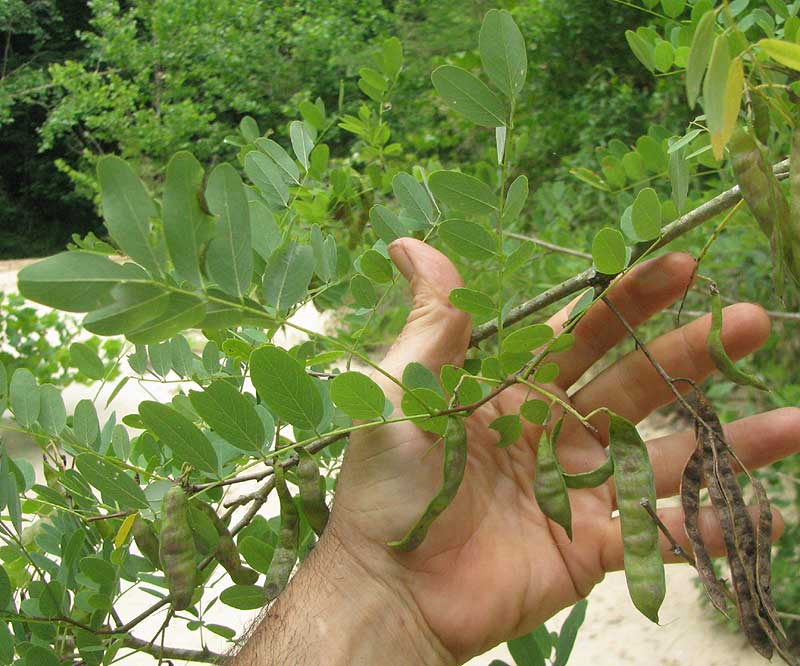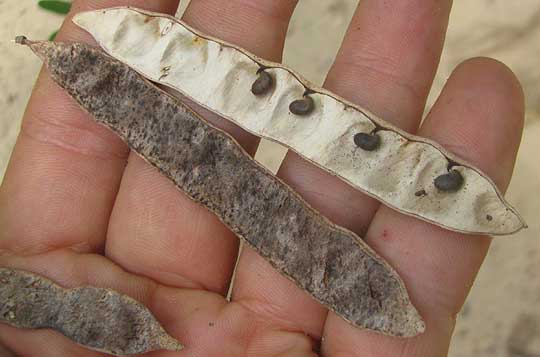Excerpts from Jim Conrad's
Naturalist Newsletter

from the June 10, 2012 Newsletter issued from the woods of the Loess Hill Region a few miles east of Natchez, Mississippi, USA
BLACK LOCUST LEGUMES
This year I missed the pretty flowers of the Black Locust, ROBINIA PSEUDOACACIA, but I'm here as the trees' stiff, thin, legume-type fruits mature, as shown above. Notice that the leaves are once-pinnately compound -- divided into 7 to 19 smooth-margined leaflets one to two inches long. A split-open legume with its hard, smallish beans nestled inside their chambers is shown below:

Black Locusts are common here in southwestern Mississippi so when I checked in my old Trees of North America field guide I was surprised to see that the species' distribution map showed us well beyond the Black Locust's two limited regions of natural occurrence -- the southern Appalachian region and just beyond, and the Ozarks. The USDA's "Plants Database" map more coincides with my experience. It shows Black Locusts present in all of the US 48 contiguous states and much of Canada. Also, on the Web I see that Black Locusts now grow wild in many countries throughout the world.
In my home area of Kentucky where heart-breakingly enormous acreages of countryside have been strip-mined for coal, much of that land has been "restored" by planting Black Locust on it. That's because Black Locust is a tough species able to live in very disturbed environments, plus, since it's a member o the Bean Family, its roots bear nitrogen-fixing mycorrhizal associations; the tree fertilizes the soil it grows in. Bees and other pollinators swarm to the flowers.
Still, apparently in most of the world Black Locusts are non-native species. In Massachusetts Black Locusts are prohibited as an invasive species. The "Global Invasive Species Database" complains that outside its native range Black Locusts compete with native plants for pollinating bees, and says that dense clones of the species create shaded islands with little ground vegetation.
So, technically, Black Locust is an "invasive" here. Nonetheless, in this fast-evolving world suffering so many attacks from so many directions, I'm glad to see the species enlisting with other plants and animals to vegetate and enrich ecosystems struggling just to exist -- just to hold the soil in place until the next clear-cutting, the next bush-hogging, and the next helicopter herbiciding.
from the May 11, 2006 Newsletter issued from Polly's Bend, Garrard County, in Kentucky's Bluegrass Region, USA
BLACK LOCUST CAUSING HAY FEVER?
Our Black Locusts are still gorgeously white with an abundance of flowers. I'm surprised that these blosoms have lasted so long. Probably it's because our weather lately has been uncommonly cool and cloudy.
The other day Ruth came down with a fit of sneezing and a scratchy throat, and she pretty much blamed it on the Black Locusts. One can hardly blame her, for that day not only where all the locusts aglow with blossoms but also their perfumy fragrance lay heavily on the landscape, below some trees the ground was snowy with fallen blossoms, and bees buzzing up among the blossoms could be heard twenty feet away. The Black Locusts were simply calling attention to themselves.
But, causing hay fever? I doubted it. Pollen causing hay fever, I reasoned, is from wind-pollinated plants. All that bee-buzzing proved that Black Locusts depended on insects for pollination. My guess was that Black-Locust pollen was too large, heavy and sticky to make its way into people's noses and lungs.
On the Internet I found a site rating hundreds of plants as to their ability to cause hay fever, giving them either a "strong" or "light" classification. Black Locusts were rated as "light." A lot of grasses, which are wind pollinated, were "strong." I'd judge our Black Locusts to be not guilty of causing Ruth's sneezing and itchy throat that day. In fact, later it developed that she had a simple head cold -- which she gave to me.
Anyway, I find that often people blame the wrong plants for their hay fever. One of the most egregious instances comes in the fall when those beautiful fields of goldenrods are blamed. But goldenrod pollen is very big and gummy, and hardly likely to get into anyone's nose.